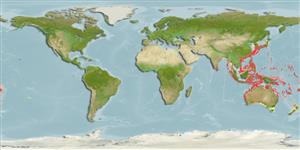Common names from other countries
Environment: milieu / climate zone / depth range / distribution range
Sinh thái học
Biển gần đáy; Mức độ sâu 85 - 154 m (Ref. 9824). Temperate
Indo-West Pacific: southern Japan to the South China Sea. Also recorded from northwestern Australia (Ref. 5978) and New Caledonia (Ref. 9824).
Bộ gần gũi / Khối lượng (Trọng lượng) / Age
Maturity: Lm ? range ? - ? cm
Max length : 17.0 cm TL con đực/không giới tính; (Ref. 9824)
Các tia vây lưng cứng (tổng cộng) : 0; Các vây lưng mềm (tổng cộng) : 99 - 106; Tia cứng vây hậu môn: 0; Tia mềm vây hậu môn: 76 - 83. Snout sharp. Maxillary extending to below or beyond middle of lower eye. No gill rakers on upper limb. Cycloid scales on ocular side. Caudal fin having 3 simple upper and lower rays. No dark blotch on pectoral and pelvic fins. Second dorsal fin ray elongated in male.
Inhabits bottoms with broken coral, shell, pebbles, and gray mud. Feeds on bottom-living animals.
Life cycle and mating behavior
Maturities | Sự tái sinh sản | Spawnings | Egg(s) | Fecundities | Ấu trùng
Masuda, H., K. Amaoka, C. Araga, T. Uyeno and T. Yoshino, 1984. The fishes of the Japanese Archipelago. Vol. 1. Tokai University Press, Tokyo, Japan. 437 p. (text). (Ref. 559)
IUCN Red List Status (Ref. 130435)
CITES (Ref. 128078)
Not Evaluated
Threat to humans
Harmless
Human uses
Các nghề cá: không ích lợi (thú vị)
Các công cụ
Special reports
Download XML
Các nguồn internet
Estimates based on models
Preferred temperature (Ref.
115969): 15.3 - 26.8, mean 21.2 (based on 167 cells).
Phylogenetic diversity index (Ref.
82804): PD
50 = 0.5000 [Uniqueness, from 0.5 = low to 2.0 = high].
Bayesian length-weight: a=0.00759 (0.00394 - 0.01459), b=3.03 (2.86 - 3.20), in cm Total Length, based on LWR estimates for this species & (Sub)family-body (Ref.
93245).
Mức dinh dưỡng (Ref.
69278): 3.5 ±0.37 se; based on food items.
Thích nghi nhanh (Ref.
120179): Trung bình, thời gian nhân đôi của chủng quần tối thiểu là 1.4 - 4.4 năm (Preliminary K or Fecundity.).
Fishing Vulnerability (Ref.
59153): Low vulnerability (10 of 100).
